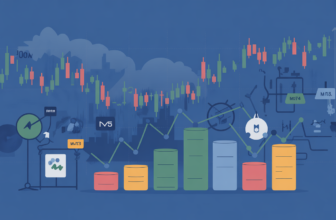
Currency trading in the forex market can be both challenging and profitable. However, to be successful, traders need to have a clear understanding of how to calculate their profits. Profit and loss (P&L) is a crucial aspect of forex trading. It directly impacts the margin balance in a trading account and determines the amount of money available for trading. By mastering the calculation of profit in forex, traders can enhance their trading skills and effectively manage their positions.
To calculate forex profit, subtract the entry price from the exit price for a long trade, or vice versa for a short trade. Multiply the result by the trade size and the pip value. Formula: Profit = (Exit Price – Entry Price) × Trade Size × Pip Value.
Key Takeaways:
- Profit and loss (P&L) calculation is essential for effective forex trading.
- Forex profits can be realized or unrealized, depending on open or closed trades.
- Calculating profit and loss involves knowledge of position size and pip movement.
- Traders should consider the quote currency and convert P&L into the account currency for margin calculations.
- A clear understanding of profit calculation is crucial for managing risk and making informed trading decisions.
How to Calculate Profit in Forex
At the core of forex profit calculation lies a simple yet critical formula: Profit or loss equals the position size multiplied by the pip movement. This foundational concept forms the basis of all profit assessments in forex trading, providing traders with a clear understanding of how market movements translate into monetary gains or losses.
Consider a hypothetical scenario involving a 100,000 GBP/USD position. If the market experiences a 15-pip upward movement, a trader with a long position stands to gain $150. Conversely, if the prices decline by 20 pips, the trader could incur a loss of $200. Real-world examples elucidate the direct correlation between market movements and profit outcomes.
Currency Denomination
Delving into the intricacies of profit and loss denomination, it’s crucial to comprehend the role of base and quote currencies. For instance, in a GBP/USD scenario, where GBP is the base and USD is the quote currency, fluctuations impact the dollar value. Converting P&L to USD for margin calculations becomes imperative, enhancing a trader’s ability to manage risk effectively.
Swiss Franc Example
Exploring a specific case, imagine holding a 100,000 short position on USD/CHF. With a movement of 10 pips, equivalent to CHF 100, understanding the conversion to USD involves dividing the P&L by the USD/CHF rate. This nuanced example sheds light on the multi-currency dimension of forex profit calculation.
Margin Calculation: The Foundation of Risk Management in Forex Trading
For participants of forex trading, understanding margin calculation is the cornerstone of effective risk management. Margin, expressed as a percentage, represents the funds a trader must have in their account to open and maintain a trading position. This section aims to elucidate the intricacies of margin calculation, shedding light on its importance and practical application.
The Basics of Margin
Margin is essentially a security deposit required by brokers to facilitate leveraged trading. Leverage allows traders to control larger positions with a smaller amount of capital. For instance, with a leverage ratio of 50:1, a trader can control a position worth £50,000 with a mere £1,000 in their account.
Margin Calculation Formula
The formula for margin calculation is straightforward: Margin = (Trade Size / Leverage). For example, if a trader wishes to open a position of 100,000 units (1 standard lot) with a leverage of 50:1, the margin required would be (100,000 / 50) = £2,000. This means the trader needs £2,000 in their account to open and maintain this position.
Influence of Leverage on Margin
Leverage amplifies both profits and losses. While it provides the opportunity for substantial gains, it also heightens the risk of significant losses. Understanding the relationship between leverage and margin is vital for traders to gauge the potential impact on their trading capital.
Practical Example: Imagine a trader with a leverage ratio of 100:1, aiming to open a position of 50,000 units on the GBP/USD currency pair. The margin required would be (50,000 / 100) = £500. This allows the trader to control a position worth £50,000 with a margin of £500.
Risk Management and Margin
Effective risk management involves calculating the appropriate position size based on the available margin. By determining the percentage of capital at risk in each trade, traders can establish a prudent approach to protect their accounts from substantial losses.
Variable Leverage and Margin
It’s important to note that leverage and margin requirements can vary between different currency pairs and brokers. Traders should be aware of these variations and consider them when planning their trades. Being mindful of the specific margin requirements for each instrument contributes to a more nuanced risk management strategy.
In conclusion, margin calculation is an integral aspect of forex trading that underpins risk management strategies. By comprehending the basics, utilising the margin calculation formula, and acknowledging the influence of leverage, traders can navigate the forex market with a more informed and calculated approach, mitigating risks and enhancing the potential for successful trading outcomes.
Realized and Unrealized Profit and Loss
In the forex market, traders can experience both realized and unrealized profit and loss. Understanding the difference between these two concepts is crucial for effective risk management and assessing the performance of trades.
Unrealized profit or loss:
Unrealized profit or loss refers to the potential profit or loss on open trades that have not yet been closed. It represents the profit or loss that a trader would realize if they were to close their position at the current market price. This calculation is based on the mark-to-market value, which is the price at which a trade can be closed.
Realized profit or loss:
Realized profit or loss, on the other hand, is the actual profit or loss when a trade position is closed. It represents the net profit or loss made from a completed trade, taking into account the entry price, exit price, and any transaction costs. Realized profit or loss impacts the margin balance in a trading account, increasing it in case of a profit and decreasing it in case of a loss.
In summary, unrealized profit or loss represents potential gains or losses on open trades, while realized profit or loss reflects the actual outcome of closed trades. Understanding these concepts is essential for evaluating trading performance and making informed decisions.
Calculating Profit and Loss
Calculating profit and loss in forex is a fundamental aspect of successful trading. By accurately determining the profit or loss, traders can make informed decisions and effectively manage their positions. The process involves understanding the position size and the number of pips the price has moved.
To calculate the profit, traders need to multiply the position size by the pip movement. For example, let’s say a trader has a position size of 100,000 GBP/USD and the price moves by 15 pips. The profit can be calculated as follows:
Profit = Position Size x Pip Movement
Applying this formula, the profit in this scenario would be $150 (100,000 x 0.0015).
It is important to note that the direction of the trade, whether it is long (buy) or short (sell), determines whether the profit or loss is realized. Traders must also consider the quote currency and convert the profit or loss into the account currency for accurate margin calculations.
Here is an example table illustrating the calculation of profit and loss:
| Position Size | Pip Movement | Direction | Profit/Loss |
|---|---|---|---|
| 100,000 GBP/USD | 15 pips | Long | $150 |
| 50,000 EUR/JPY | -20 pips | Short | -$200 |
| 75,000 AUD/CAD | 10 pips | Long | $75 |
By understanding and implementing the process of calculating profit and loss in forex, traders can better analyze their trading strategies, manage risk, and maximize their potential for profit.
Conclusion
Calculating profit in forex is crucial for traders to effectively manage their trades and navigate the dynamic forex market. By understanding the mechanics of profit calculation, traders can accurately determine the margin required for holding a position and effectively manage risk.
To ensure accurate and efficient profit calculation, it is important for traders to rely on automated brokerage accounts that provide real-time profit and loss calculations. These accounts take into account factors such as position size and pip movement, saving traders time and effort.
However, it is equally important for traders to familiarize themselves with the calculations involved in determining profit. By learning these calculations, traders can structure their trades, make informed decisions, and gain a deeper understanding of their trading positions.
Having a clear understanding of profit calculation in forex trading is a key factor in achieving success in the forex market. It enables traders to effectively manage their trades, optimize their profit potential, and minimize losses. By mastering profit calculation, traders can enhance their trading skills and improve their overall performance.
FAQ
How do I calculate profit in forex?
To calculate profit in forex, you need to know the position size and the number of pips the price has moved. Multiply the position size by the pip movement to determine the actual profit or loss.
What is the difference between realized and unrealized profit and loss?
Unrealized profit or loss refers to open trades that can be closed at any time and is calculated based on the mark-to-market value. Realized profit or loss, on the other hand, is the actual profit or loss when a trade position is closed.
How can I calculate profit and loss in the forex market?
Calculating profit and loss in forex requires knowledge of the position size and pip movement. Multiply the position size by the pip movement to determine the profit or loss.
Why is calculating profit in forex important?
Calculating profit in forex is important for effective trade management and risk control. By understanding how to calculate profit, traders can determine the margin required for holding a position and make informed decisions.

















